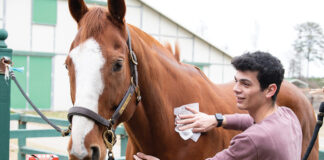 |
Did show season sneak up on you and your horse? Does everything about an upcoming show look appealing, except your horse? Well, take heart. Even though the clock is ticking, here are 10 steps that’ll help transform your barn beast into a blue ribbon beauty.
9. Even if the show is only 30 days away, you can still work wonders with the coat of an otherwise healthy horse. Consider adding a feed supplement that is designed specifically for coat enhancement. Most are formulated to add fat to the horse’s diet, which can help promote a sleek, shiny hair coat. Vigorous daily grooming of your horse helps enhance shine, too. Really, really rub on him with a soft curry to loosen old winter hair and bring skin oils to the surface. Try not to shampoo him too often, as that will only strip away the natural shine you’re trying to encourage. If your horse is spending hours in daytime turnout, invest in some lightweight loungewear. A scrim sheet will help shield his coat from the sun, which helps prevent dark horses from bleaching to the color of burnt toast. At night your horse can wear sleek sleepwear. A daysheet made of non-abrasive material such as nylon will not only protect his coat, but also help the hair to lie flat.
8. About two weeks ahead of show time, turn your attention to your horse’s tail. A long, full tail adds to the aesthetic appeal of a show horse. While tail extensions are commonplace in the western show pen, if you can work with Mother Nature and avoid them you’ll save money and grooming time. Dressage and hunt-seat riders aren’t as fond of fake tails, although they’re becoming more acceptable when the alternative is a mere wisp of hair. How might you forego the fakery?
First begin with a thorough shampoo to enrich the tail’s true color. If your horse’s tail is white, silver or flaxen, select a product that’s made to remove stains and whiten yellowed hair shafts. Most of these shampoos will be blue or purple in color, so make sure that you follow directions and rinse thoroughly, otherwise you may end up with a tail that’s a murky shade of green or lavender. Next, add a conditioner. Pay extra attention to the top of the horse’s tail where scurf tends to collect and where short hairs are apt to stick out. After rinsing that out, allow the tail to dry before applying a detangler. Use your fingers to pull apart any knots or twisted hair, being careful not to yank out any strands. Finish up with a tail brush, removing leftover snarls. Finally, braid the tail and encase it in a tail bag. Repeat the tail detail every three or four days, and your horse will have a much nicer rearview.
7. The show is only three days away. If you’re lucky you’ll only need to concentrate on performing a standard show trim: muzzle whiskers, bridle path, ears and the long hair on the fetlocks. Horse hair grows quickly, so by waiting until the show is no more than 72 hours away to trim, you’ll keep your horse from sporting a 5 o’ clock shadow in the show-ring. For a close shave around the muzzle and inside the ears, use a #30 blade. For the bridle path and fetlocks, swap in a #10 blade that is less likely to reveal errors.
6. Ideally, within your 72-hour window of pre-show prep time, you should address any white socks or stockings your horse might sport. Such chrome adds to your horse’s flashiness, but it also means you have to get these socks sparkling clean. Want to catch the judge’s eye? If you’re handy with the clippers, use a #10 blade and clip against the growth of the hair. That’ll remove any hair full of stubborn yellow stains. Or you can play it safe and cleanse those white legs with your whitening shampoo: Put it on full strength and allow it to soak in for three to five minutes before rinsing thoroughly. When the hair is dry, spritz each leg with a coat polish and wrap with standing wraps (quilts and bandages). That’ll prevent a new buildup of stains right before show time.
Now is also the time to shorten and thin your horse’s mane to its desired length. Metal mane combs have long been the traditional tool for pulling out the hair at the roots. But not many horses enjoy that salon treatment. A kinder, gentler instrument is a mane knife with an edge like a clipper blade. You can zip through your horse’s mane in a few minutes with nary a snarled equine lip conveying displeasure. If you’ll be banding your western horse’s mane, shorten it to where it ends in a line that parallels that first thick muscle beneath the crest. English manes can be a bit longer for braiding.
5. Depending on the show facility’s amenities, your class schedule and the weather, you may be able to shampoo your horse a few hours before competition. But that’s not often the case. So plan on being at home when you suds up your steed, preferably 24 hours before the show.
There are a variety of good equine shampoos on the market, including color enhancing shampoos, such as formulas for dark horses, silver horses, chestnuts and even palominos. To make your job easier, there are spray nozzles available that attach to quart-sized or larger shampoo containers, and then to your hose. Flip a plastic toggle and voilà! It’s like your horse is at the car wash. During the bathing session, make sure you saturate the mane, removing dirt and debris lodged at the roots. Before your horse dries completely, spray or wipe on a coat polish. This will repel dust and help the hair lie flat. Just beware of using it in the saddle area, as some of these products contain silicone and make anything that touches it incredibly slippery. And keep it out of the mane or you’ll never be able to grip the hair for braiding or banding. Finally, put your horse to bed in a daysheet to ensure that your time shampooing wasn’t in vain. Nothing spells mental anguish like going to fetch your allegedly spotless horse and discovering he napped in the dirtiest spot in his stall.
4. The afternoon before the show is also the perfect time to unveil the tail. Slip it out of the bag, loosen the braid and examine if anything needs to be done to make it even more spiffy. In general, mature western pleasure horses have their tails cut blunt across the bottom, about even with the hind fetlocks. Doing so eliminates a sort of gradual fade to nothingness at the end. It’s a matter of personal taste in hunters, whether to snip off the bottom evenly or leave it in its natural state.
Dressage riders bang their horse’s tails just above the fetlocks with a straight cut. Eventing riders also bang the tail, but higher up—just below the hock. If you want this blunt geometric effect at the end of the tail, have a helper place an arm under your horse’s tail bone and lift it until it resembles your horse’s natural tail carriage. Now, gently snip off the ends so that they’re level in this position and the tail appears even when your horse is in motion.
Dressage and eventing horses often have their tails pulled as well as banged. A pulled tail has the hairs at the dock and along the tail bone shortened to accentuate the hindquarters. In days past, tail hairs were actually yanked out, but today the look is commonly achieved with a set of clippers or scissors. If you’ve never tried this technique, have an expert grooming friend show you how. Otherwise you could create a porcupine effect.
3. The night before the show—or very early in the wee hours of the morning—is the time for the mane event. Your earlier shampoo left the mane clean. Now you can band or braid it. In either case employ gel or a sticky braiding agent to force the hair into cooperating. Then, as you braid or band, keep downward tension on the hair; never pull the section of hair toward you as you work. That will cause your finished project to stick out and away from your horse’s neck, the exact opposite of the look you’re going for. Want to preserve your hard work? Pull a stretchy hood over your horse’s head and neck. That’ll keep bedding out of the mane and thwart your rascal’s attempts to sabotage his coiffure with rubbing.
2. It’s show time! About an hour before your class, begin the final grooming ritual. Customize any chrome leg markings with whitening agents. The days of dusting white stockings with cornstarch are gone. Blocks of French chalk (like those used in grooming show dogs) or specially formulated water-based, washable coat sprays make sprucing up the white trim a quick, clean task. While you’re hoofing it, give your horse a last minute pedicure of sorts. For some disciplines it’s standard to apply a liquid hoof polish: clear for light hooves, black for dark. English performance horses in open shows stick to a more casual approach. Clean hooves are simply painted with hoof oil. Oiled hooves still present an affirmation of attention to detail on the part of the exhibitor.
1. What do you do right before you head into your class? At the back gate, zone in on making your horse look like a star by giving his body and face a once-over with a soft, lint-free cloth. A dab of equine highlighter on the cloth can enhance your horse’s features and add a matte shine: Gently wipe the corners of his eyes, the inside of his ears, the curves of his nostrils and last but not least, his lips. No horse should be wearing an alfalfa green or carrot orange smile in front of the judge.
A mist of coat spray will add microscopic gleaming beads to the hair shaft, and a dash of fly spray (non-oil based, so as not to attract dust) will prevent a head-shaking tantrum at the wrong moment. Now your horse will shine like a trophy! True, these good looks may require some forethought and preparation, but when your horse looks like a champ, you’ll feel like one, and that’ll help you ride all the better.
Cindy Hale is the author of Riding for the Blue and A Passion for Horses.







i no on show days for me since i do barrel racing is all my frineds and i get everything in the trailer then leave and when we get there and a bridle breaks were lik um… does anyone have an extra bridle so its good to have a check list :]]thanks for the advice
very helpful!
Boy, more great information. As I keep learning, I will have to start deleteing things from my brain, to make more room for all the new horse information I am learning. 🙂
Thanks, next time when i show my horse i will always now to keep her shineing like a star me to.
And i will keep me and my Horse happy and healthy when show for barrel raceing thanks for every thing!kilee.
Really made me think about how im going to groom for our next show!
this is awesome! Already starting at number one for our next show. I used to have my mare on a pleasure feed for a long time but now I’ve made sure I get the good stuff.